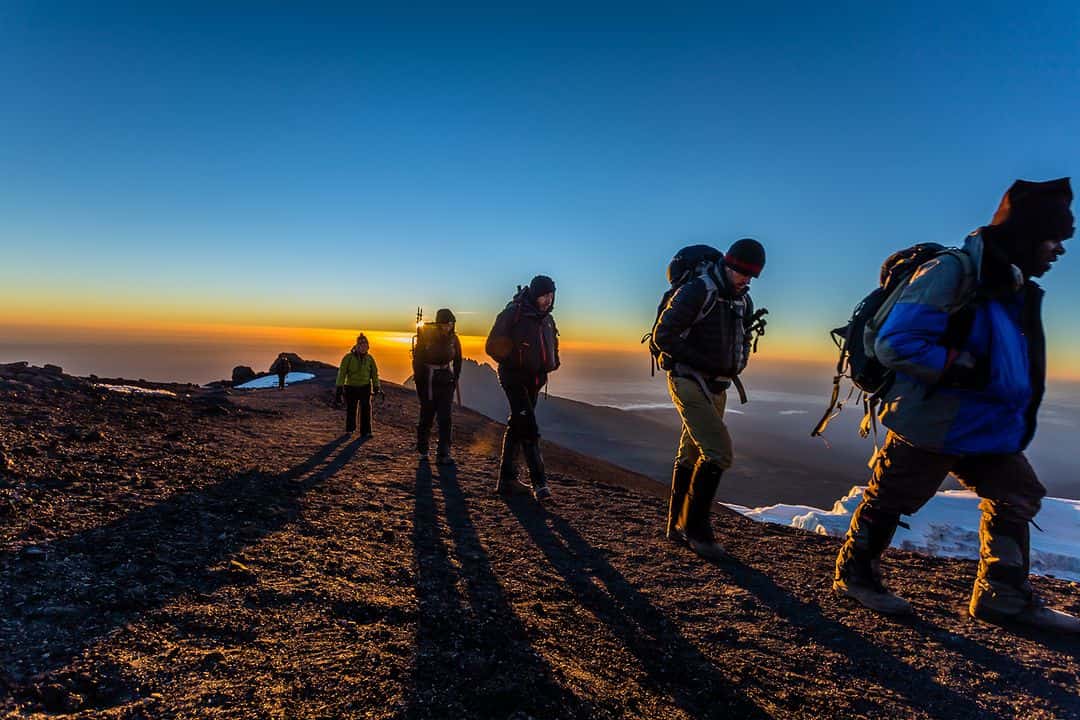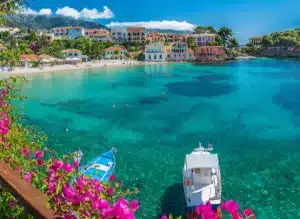Mount Kenya is like the ultimate trekking spot in Kenya! Sure, most people think of Kenya for its beaches and safaris, but this mountain is a hidden gem for adventure seekers.
And yes, most folks can name the highest mountain in Africa, but did you know that Mount Kenya is Africa’s second-highest mountain? Standing at 5,199 meters, Batian Peak is just a tad taller than Nelion (5,1888 m) and Point Lenana (4,985 m).
If you’re up for climbing the first two peaks while on a trek on Mount Kenya, you’ll need some rock climbing experience. But if you’re aiming for Point Lenana, all you need is a good pair of hiking boots. You can conquer the third-highest peak of Africa’s second-highest mountain with just a few days of hiking.
This massif is perfect for those who love a good challenge in a breathtaking setting. Even though it’s on the equator, the main peak Batian, is a real showstopper with its snow-capped glaciers. Visitors flock here year-round for the breathtaking views! It’s a fantastic spot for nature lovers and climbers looking for a challenge. With three peaks to conquer, you can tailor your climb to your skill level and make it as tough as you like.
The hike to Point Lenana is achievable for anyone, especially if you take your time. Going at a leisurely pace is the secret to steering clear of altitude sickness and making it to your goal with ease. Once you hit 3000 meters, it’s totally fine to take it easy. And don’t forget to drink lots of water to keep yourself well hydrated.
Related read: Reasons to Visit Kenya
Here’s an overview:
Different Routes To Trek to Point Lenana on Mount Kenya
Here is a breakdown of the different routes to take on your trek on Mount Kenya.
Naro-Moru Route
This route is the quickest way to reach Point Lenana. It starts from Naro-Moru Gate, passes through Meteorological Station, Mackinder’s Camp, and finally reaches Point Lenana.
This route was one of the most popular choices because it’s short and has convenient huts at Met Station (3050m) and MacKinders (4200m). The forest along this route is still lush, with a dense bamboo zone. Many climbers typically start at the park gate, but driving up to the Met Station (3050 meters) is possible.
The trek along Naro Moru offers a unique experience, leading you through a vertical bog into the expansive Teleki Valley below the Lewis Glacier. In the Teleki Valley, you’ll encounter iconic Tree and Cabbage Groundsels and Lobelia Telekii and Deckenii.
Sirimon Route
The route is usually considered one of the easier ones, as it climbs gradually with just a few steeper sections to reach the top camp. It’s currently the most popular route but not overly crowded.
Begin your adventure from Nanyuki and head to Sirimon Gate, then make your way through Old Moses Camp, Shipton’s Camp, and finally reach Point Lenana.
The forest is sparse along this route, and the bamboo zone isn’t very prominent. Most of the second day is spent in the alpine heath and moorland. When you cross the ridge into the MacKinder Valley, you’ll have a great viewpoint if the weather is clear. The approach to the peaks along the classic U-shaped MacKinder Valley can be stunning in good weather. The MacKinder Valley is home to many giant Lobelia and Groundsel, the classic flora of Mt. Kenya. You will also likely spot Rock Hyrax at Shipton’s cave or hut.
This is also the route that we recommend in more detail below.

Chogoria Route
For a scenic journey, start at Chogoria and pass through Chogoria Gate, Minto’s Hut, and make your way to Point Lenana.
The Chogoria route on Mount Kenya is often hailed as the most beautiful route to take. While there isn’t a high camp hut along the way, the journey can be made shorter by using 4×4 vehicles to skip the lower section. It’s common practice to drive 4x4s through the forest until you reach the Meru Bandas at 3000m.
Just past the junction near “The Temple” at 4300m, you’ll find an old, somewhat shaky hut where porters usually spend the night, while clients have to set up camp.
What sets this route apart is its stunning physical landscape. Unlike other routes that follow a U-shaped glacial valley, the Chogoria winds around the impressive ‘Temple’ with Hall Tarns above it and Lake Michaelson at the base of the amphitheater. Additional highlights like Lake Ellis, the Giant’s Billiard Table, and the Nithi Falls make this route even more captivating.
Many climbers choose to descend via the Chogoria after ascending other routes.
Burguret Route
Don’t forget about the Burguret Route (known for its ruggedness and less-traveled paths).
The Burguret route may not be as popular due to its challenging navigation and lack of amenities. However, the rugged, undeveloped nature of the trail and the possibility of having it all to yourself can be a draw for some adventurers.
Unlike other routes, Burguret doesn’t have a clearly marked path or any facilities like huts. You’ll need to arrange with the rangers in advance and make payments at a different gate since there’s no Park Gate on this route.
Navigating through the bamboo forest in the lower section might require some guidance from the guides, especially if there haven’t been recent hikers. The route can vary until you reach the first camping spot at Kampi Ya Machengeni (3000m) in the moorlands.
The next stretch is more open and easier to navigate, but you’ll still need to carve out your own path rather than follow a set trail.
Timau Route
The Timau Route, located on the north side, is also rarely traveled.
It used to be a popular route for driving up in a 4×4, as it winds its way through the milder northern slopes before getting steeper at around 4200m.
From there, it descends sharply into and across the Hinde Valley and the Nithi North River before ascending to meet the Chogoria Route at Hall Tarns.
The route’s conditions vary, but vehicles typically don’t exceed around 3400m.
While it’s still technically possible to climb via this route, it’s recommended to consult with the Rangers for current conditions.
Our Recommendation: Sirimon Route
Fit adventure trekkers will find the Sirimon Route on Mount Kenya to be a fun and easily accessible trekking route. There is greater scenery than Naromoru, and some of the best walking is available on the dry side of the mountain.
Ascend through the woodland and onto a broad slope to reach the summit location. The route begins close to Nanyuki on the northwest face of the mountain.
The bunkhouse amenities are the greatest on this side of the mountain, and access is sufficient.
Starting from the bottom and hiking your way up, you’ll be treated to a truly diverse landscape. The trail takes you through a mix of deciduous forest, gallery forests, and the lush Afroalpine rainforest at the base of the massif. As you continue, you’ll pass through mountain cloud forests, bamboo groves and unique plant life like giant heaths and coso trees, bogs, and grasslands.
As you ascend, you’ll encounter impressive senzenzias and lobelias before reaching the top with its stunning rock and ice formations. There are 800 plant species in this area, with 81 found nowhere else – a colorful display of rare and tropical nature that’s truly a sight to behold.
If you hang out on the lower slopes among the lush forests and bamboo thickets, you might catch a glimpse of elephants, bushbucks, giant forest hogs, and even buffalo. On the other hand, the Afroalpine heights are home to massive tree heaths, quirky giant senecias and giant lobelias, with rock hyraxes keeping hikers and climbers company.

4 Days Up and Down Sirimon Route
Here’s a breakdown of the four days of trekking to Point Lenana on Mount Kenya.
Day 1: Nairobi / Nanyuki / Old Moses
Departure from Nairobi at 0700 hrs from your hotel and transfer to Nanyuki, arriving after 3 hours. Later transfer to Sirimon gate and hike to Old Moses camp for overnight (3300m), 3 to 4 hour hike (9kms). Old Moses camp is where you acclimatize as you also come across different vegetation.
Old Moses Camp is not just a resting spot; it’s where the magic of acclimatization begins.
As you traverse through various vegetation zones, from lush forests to open moorlands, keep an eye out for unique flora and fauna. This initial leg of the journey acquaints trekkers with the diverse ecosystems that characterize Mount Kenya.
Day 2: Old Moses – Shiptons
After a hearty breakfast, you’ll embark on a scenic hike to Shipton’s Camp, situated at an elevation of 4200 meters. The trail meanders through Liki and Makinders valleys, treating trekkers to breathtaking vistas of rugged landscapes and towering peaks. This portion of the journey typically spans 6 to 8 hours, covering a distance that varies based on the pace and stops along the way.
Shipton’s Camp serves as a high-altitude base for trekkers, offering essential amenities amidst the raw beauty of Mount Kenya.
Keep your camera handy to capture glimpses of wildlife, such as rock hyraxes, duikers, and various bird species that inhabit these high-altitude regions.
Day 3: Shipton Camp / Point Lenana / Judmaier Camp (Old Moses Camp)
This is the pinnacle of your Mount Kenya adventure as you set out for the summit bid in the early morning hours. Departing from Shipton’s Camp at 3 am, the ascent begins with a challenging climb up a steep stony quarry, which eventually leads to Lower Hall Tarns.
The trail offers awe-inspiring views as you ascend towards Point Lenana, Mount Kenya’s third-highest peak, standing at approximately 4985 meters above sea level.
Reaching Point Lenana around sunrise rewards trekkers with a spectacular panorama of the surrounding peaks and the vast expanse below. After soaking in the majestic sunrise, the descent back to Shipton’s Camp takes around 2 hours, where a well-deserved breakfast awaits.
The journey continues as you descend further to Old Moses Camp, retracing your steps through familiar terrain for approximately 4 hours.
Day 4: Judamaier Camp (Old Moses) / Sirimon / Nairobi
On the final day of your trek, after a satisfying breakfast, you’ll bid farewell to the mountain and begin the descent through the lush rainforest. The trail winds its way down for about 2 hours, offering trekkers a chance to reflect on their journey amidst the tranquility of the forest.
As you emerge from the dense vegetation, you’ll reunite with your transport vehicle, marking the end of your Mount Kenya adventure.
The return journey to Nairobi is filled with memories of exhilarating challenges, breathtaking landscapes, and the camaraderie forged during the trek.
Contact the Alpine Holidays team through the form below, get more info or book your trekking adventure of a lifetime.
They will usually respond to your message within 24 hours.
When Is the Best Time To Climb Mount Kenya?
Mount Kenya is a fantastic climb any time of the year!
In April and May, you might encounter a longer rainy season, while November brings a shorter one.
If you’re looking for optimal conditions, plan your trip from January to March or June to October. This way, you can avoid the rainy season and enjoy the finest weather and views.
Keep in mind that mountain weather can be unpredictable, so all seasons might make an appearance at any time. But sticking to those prime seasons will give you the most bang for your buck.
Being near the equator, it can get pretty chilly at night and the summit, so make sure to pack warm clothes or a cozy sleeping bag. On the lower and middle slopes, get ready for tropical heat and high humidity.
Dressing for big temperature swings is key for a successful trek!

Travel Preparations for Mount Kenya
For your adventure, make sure you have comfy shoes, cozy rain-resistant gear, a cool hat, and gloves.
If you’re tackling those peaks, don’t forget your climbing gear! Bring maps, water, snacks, camping gear, and a trusty compass.
And, of course, pack a first aid kit just in case.
Don’t miss out on capturing the views with a camera and binoculars, and protect yourself from the sun with a sun hat, sunscreen, and stylish sunglasses!
Related read: Trekking Essentials to Carry While Hiking
The view from the top looking out over the endless deserts, savannas, and rainforests totally makes all that hard work worth it in the end.
Plus, come on, how many people can say they’ve seen snow at the equator?





